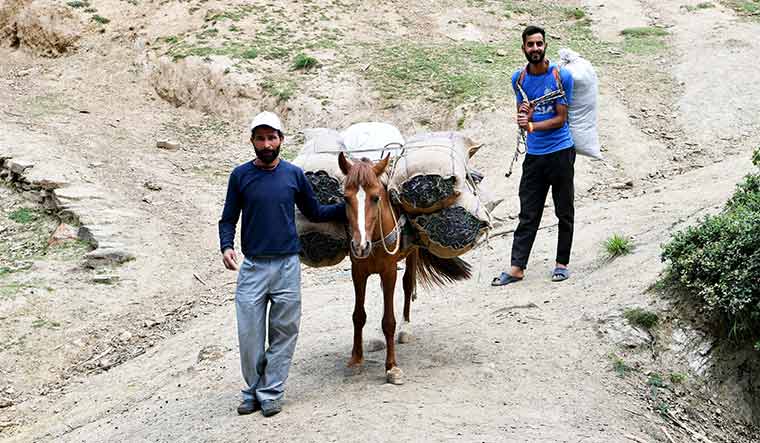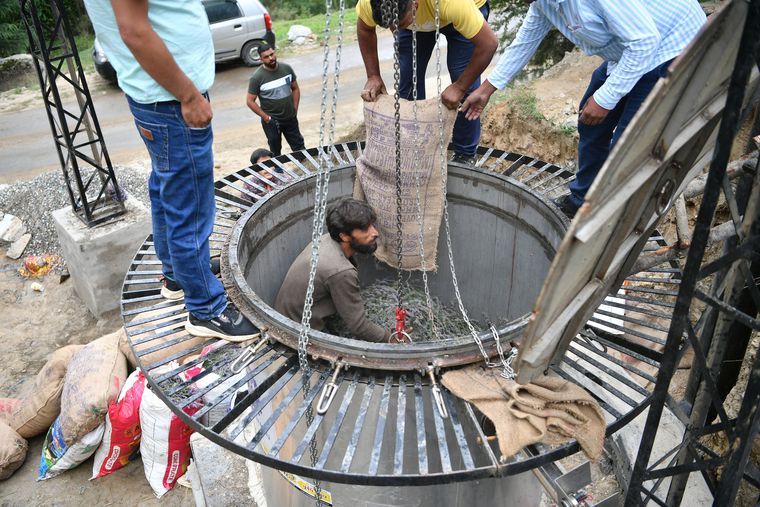IT WAS DUSK. We had travelled for nearly six hours from Jammu, and reached Bhaderwah, a region of low, rolling hills and picturesque valleys. The weather being a huge improvement on the Delhi heat, we rolled down our windows. And suddenly, a heady floral scent hit us. Looking out, we gazed at a tiny plot of land, swathed in mauve, the colour in sharp contrast with the green hillside beside the highway.
We stopped the car and stepped out to be greeted by a beaming Om Nath, who was carrying a five-litre jerrycan. Nath is one of the many subsistence farmers in the region who are smiling despite this year’s drought. The jerrycan holds freshly extracted lavender oil, which will easily fetch him Rs50,000. He is so glad he shifted from cultivating maize, which brought him barely Rs4,000 a harvest (though the meagre crop was mostly consumed by the family itself).
There is a purple revolution afoot in the region, aided by the Union government’s Aroma Mission, which aims to inject scientific research and development into the cultivation of aroma crops (from which high-value essential oils are extracted) like lavender, rose, lemon grass, rosemary and wild marigold. The Centre for Scientific and Industrial Research (CSIR), through its various institutions across the country, is spearheading the mission. Jammu’s Indian Institute of Integrative Medicine is the nodal institute.
Lavender was brought to the Kashmir valley many decades ago, said Sumit Gairola, nodal scientist for Aroma Mission. However, its cultivation was restricted to a few patches, and it did not take off in a big way. “In 2010, we brought the crop out of the valley. We had developed a variety, RRL12, after three decades of research and were ready to introduce it in Doda and Bhaderwah.”
Since lavender is not an Indian native, scientists worked on the imported varieties as well as the indigenised ones from the valley, combining and recombining favourable traits in their petri dishes (like high oil yield, better quality of oil, better resistance to Indian climes), till they had developed a line which they were ready to take from their research gardens to the larger farms. The work is slow and painstaking. With every new combination of genetic traits, scientists have to wait for the plant to mature and flower before they can extract the oil and confirm if it is of the quality they had hoped for. At every stage, they work on two or more combinations, and then discard the inferior ones.
By 2015, some 20 farmers in the region had tentatively agreed to try out the new crop. In 2017, however, when the government launched the Aroma Mission, the initiative got an impetus. There was now interest from the Centre in encouraging the cultivation. Jitendra Singh, Union minister of state for science and technology, said that there was a misconception that startups are about IT only when there was so much potential for agri startups, and the aromatic area was a completely unexplored one. “Scientists contribute to this endeavour by developing lines that generate quality produce, and that can augment incomes many times over. Those youngsters who made the move to lavender cultivation early are already success stories. Aromatics will attract technically qualified people also to leave city jobs and move to cultivation and processing startups.”The minister said he foresaw aromatics and dairy as the two leading sectors agri startups, revenue and employment generation.
Tackling farmer hesitancy initially required consistent effort and outreach. “We did not want to replace high food yielding fields; we have focused instead on marginal farmers, who had low food harvests,”Gairola explained. Last year, this belt yielded around 8,00 litres of oil. This year, the expectation is much more. The quality of the oil is also improving, from around 1.8 per cent of the fresh weight of the flower to as much as 3 per cent. Currently, 500 farmers are growing lavender. Senior scientist V.P. Rahul recalls the time the scientists went around with cuttings, imploring farmers to try them out. Today, there are scuffles at sapling distribution drives, and farmers even scavenge for stalks that fall to the ground.
A lavender plant lasts 10-15 years and begins yielding harvest from its first year. Propagation, said Gairola, was through cuttings to ensure the quality of the crop. Thus the line being propagated in India is seedless. With seed propagation, which is reproductive, the desired traits may get diluted or lost over generations. Vegetative propagation is a non reproductive method, in which there is no mixture of germ plasm, so the traits remain the same, generation to generation.
Lavender requires minimal inputs. It can grow even during drought years and needs just farmyard manure. Like most aromatics, it is resistant to pests. In one field, we saw sheep grazing on grass, but leaving the scented lavender plants untouched.
The next day, we reached Tipri, a remote village which does not have a road leading to it. The only way to reach it is by trekking uphill, a journey that can take about an hour, along treacherous pathways. Once we reached, however, the ardours of the journey were forgotten as we gazed at entire hill slopes draped in the sweet-smelling lavender, the hum of myriad honey bees lending music to this vista. “We are the first village to be almost 100 per cent into lavender cultivation,” said the sarpanch, Om Raj. “Last year, we got three quintals of oil. The prosperity will change the lives of our farmers.” He showed us a small patch of maize, where the crop had shrivelled. The fields here are rain-fed, and the drought was severe. The harvest was on, the women busy cutting the flower stalks with their sickles. “I am definitely going to demand a new piece of jewellery this year,” said a young girl. It is the first lavender harvest for her family, and they are thrilled. If there is good rain, there may be a mini post-monsoon crop, too.
Already, there are local success stories. Farmer Kunjlal Bhagat was among the first to shift to lavender. Today, he maintains a nursery with around three lakh plants. Farmer Bharat Bhushan, who converted in 2010 and was called a weirdo, is now an award-winning farmer and local celebrity.
The flowers are collected in bags and transported on mules to the various distillation units CSIR has set up across the region. “Till recently, we used to bring a mobile unit from Jammu for distillation. This year, we set up 11 units,” said Rahul.
The floral harvest is fed into the unit, each run can carry around 500kg of flowers. The units are wood-fired, and the oil is extracted through boiling and distillation. The extraction is best when flowers are freshly cut, and we saw farmers booking their slots for the next few days. The harvesting season will continue for around a fortnight or so. The team of scientists working on the project are young and enthusiastic and spend as much time in the big fields as they do with their petri dishes and distillation setups. There are constant learnings on the field. “The quality of the produce can be affected by the conditions on the field, too. We once had a farmer who had a small patch of garlic near his lavender field. Garlic and onion have some very strong smelling compounds like allicin, which can impact the quality of a crop like lavender, which is grown for fragrance,” said Rahul.
In one lavender patch, he noticed a lot of caterpillars. Although the crop is largely resistant to pests, this year, being a drought year, only this plant has thrived in the fields. So it attracts tenacious pests. “Do not fertilise fields with fresh cow dung; it is full of pests,” Rahul advised the farmer who was a bit worried that his flowers were not as colourful as the others because of the pest attack. “Use treated farmyard manure instead.”
Most of the oil right now is being procured by a local industrialist-farming family, the Bagbans, who then sell it to dealers across the country. “Farmers want instant gratification for their produce, and it is important they get paid immediately. So their interest in lavender cultivation continues,” said Touqeer Bagban, 35. The Bagbans alone, however, cannot sustain the growth of the industry and there needs to be more players entering the scene. This year, the government has gone on a publicity blitz to attract industry representatives from across India. For the endeavour to thrive, there needs to be awareness of the produce and a steady demand. If industrialists pre-buy harvests, like they do for potatoes, farmers are guaranteed steady income.
Lavender oil is used in perfumery, cosmetics and therapeutics. It has a calming effect and is a stress buster. Bulgaria and France are the leading producers, and nearly all lavender oil in use in India is Bulgarian, which comes at Rs 8,000 a litre. In India, the cost is Rs 10,000 a litre. Lowering the price may affect farmers. “We have to create awareness about the superiority of our product, and develop a niche market,” said Baghban. “Else surviving in a competitive market will be difficult.”
Lavender oil distillation has two byproducts. One is marka, or the waste flowers and stalk after extraction. They are fragrant and can be used to make incense sticks. The other is the hydrosol, or the lavender scented water, which can be collected by the gallon. It makes for room sprays, bathroom fresheners and body sprays. Even dried stalks of lavender flowers have a good market, as they retain their perfume for two years.
So the work of the scientists has not ended with introducing the crop to the valley. In the next stage, they will work on maximising the output from the by products. “There is potential for augmenting income from lavender cultivation; this is just the beginning,” said Rahul. CSIR hopes to introduce the crop across states with similar climatic conditions, from Himachal Pradesh to Arunachal Pradesh.




